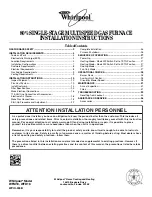
46
SERVICING
S-4 CHECKING TRANSFORMER AND Control CIR-
CUIT
A step-down transformer 120 volt primary to 24 volt second-
ary, 40 VA (Heating and Cooling Models) supplies ample
capacity of power for either operation.
WARNING
HIGH
VOLTAGE
D
ISCONNECT
ALL
POWER BEFORE SERVICING OR
CHANGING ANY ELECTRICAL WIRING.
M
ULTIPLE POWER
SOURCES MAY BE PRESENT.
F
AILURE TO DO SO MAY CAUSE
PROPERTY DAMAGE, PERSONAL INJURY OR DEATH.
1. Remove blower compartment door to gain access to the
thermostat low voltage wires located at the furnace inte-
grated control module.
2. Remove the thermostat low voltage wires at the furnace
integrated control module terminals.
With Power On (and Door Interlock Switch closed):
L
INE VOLTAGE NOW PRESENT
WARNING
3.
Use a voltmeter, check voltage across terminals R
and C. Must read 24 VAC.
4.
No voltage indicates faulty transformer, open fuse, bad
wiring, bad splice, or open door interlock switch.
5.
Check transformer primary voltage at incoming line
voltage connections, fuse, splices, and blower door in-
terlock switch.
6.
If line voltage is available to the primary side of trans-
former and not at secondary side, the transformer is
inoperative. Replace.
7.
After completing check and/or replacement of trans-
former and check and/or repair of control circuit, rein-
stall blower compartment door.
8.
Turn on electrical power and verify proper unit opera-
tion.
L
INE VOLTAGE NOW PRESENT
WARNING
WARNING
HIGH
VOLTAGE
D
ISCONNECT
ALL
POWER BEFORE SERVICING OR
INSTALLING THIS UNIT.
M
ULTIPLE POWER SOURCES MAY
BE PRESENT.
F
AILURE TO DO SO MAY CAUSE PROPERTY
DAMAGE, PERSONAL INJURY OR DEATH.
S-16A CHECKING AIR CIRCULATOR BLOWER
MOTOR (MULTI-SPEED ECM MOTOR)
D
ISCONNECT
ALL
POWER BEFORE SERVICING.
WARNING
1. Remove blower compartment door to gain access to the
circulator blower motor and integrated ignition control.
2. Check for any obstruction that would keep the fan wheel
/ fan motor from turning.
3. Check wiring, the motor has two wiring harnesses, a
main harness and a control harness. The main pin har-
ness has:
White neutral wire connected to the Neutral terminal on
the control board.
Black wire connected to the CIRC H terminal on the con-
trol board.
Red wire connected to the COM terminal, which is a
female spade connection next to the T1 – T4 wires on
the control board.
Green ground wire connected to cabinet ground
The control harness has:
Blue wire connected to T1 on the control board.
Red wire connected to T2 on the control board.
Orange wire connected to T3 on the control board.
Black wire connected to T4 on the control board.
The multi-speed ECM motor requires a line voltage power
supply (black connected to CIRC H and white connected
to neutral on the control board) as well as a signal on
one of the speed taps (T1-T4).
The speed tap voltage is D.C. and can vary depending
on S2 DIP switch selection. The voltage reading from
any one of the speed taps is referenced between the
female COM terminal next to the speed taps on the con-
trol board. From COM to T1 or T2, 6-7 VDC when ener-
gized. From COM to T3, 13-14 VDC when energized.
From COM to T4, 6-7 or 13-14 VDC depending on S2
settings.
S-200 CHECKING DUCT STATIC
The maximum and minimum allowable external static pres-
sures are found in the specification section. These tables
also show the amount of air being delivered at a given static
by a given motor speed or pulley adjustment.
The furnace motor cannot deliver proper air quantities (CFM)
against statics other than those listed.
Too great of an external static pressure will result in insuffi-
cient air that can cause excessive temperature rise, result-
ing in limit tripping, etc. Whereas not enough static may
result in motor overloading.













































